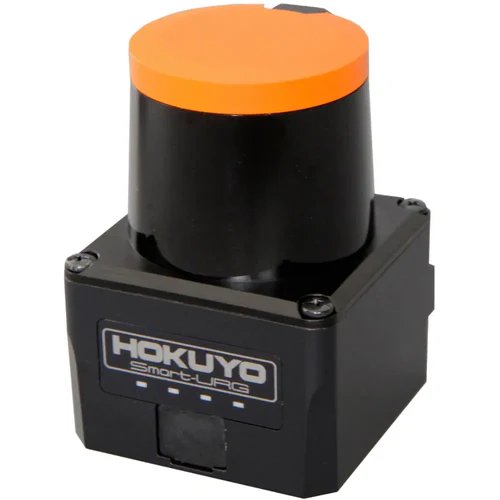Hokuyu Lidar scanners
Hokuyo sensors are LiDAR (Light Detection and Ranging) sensors that are used for scanning and mapping environments. They work by emitting laser beams and measuring the time it takes for the beams to return after hitting an object, allowing the sensor to calculate the distance to that object. Hokuyo sensors are widely used in robotics, automation, autonomous vehicles, and various industrial applications due to their precision and reliability in detecting and mapping objects.
How Hokuyo Sensors Work:
- Laser Emission: The Hokuyo LiDAR sensor emits a laser pulse that travels through the environment. When the laser hits an object or surface, the light is reflected back to the sensor.
- Time of Flight: The sensor measures the time it takes for the laser pulse to return, known as the time of flight (ToF). By calculating this time, the sensor determines the distance between itself and the object that reflected the laser.
- Rotating Mirror (for 2D and 3D Scanning): Some Hokuyo sensors use a rotating mirror mechanism to scan the environment in a wide, 2D or 3D field of view. As the mirror rotates, the sensor continuously emits laser pulses, creating a detailed point cloud or map of the surroundings based on the distances measured.
- Data Processing: The sensor processes the distance data in real-time, producing a map or a set of coordinates representing the locations of objects in the environment. This data can be used by various systems, such as robots, to navigate or interact with the environment.
- Output: The sensor outputs the scanned data to a connected computer, robotic system, or control unit. This data can be used for applications such as obstacle avoidance, navigation, environment mapping, and more.
Key Features of Hokuyo Sensors:
- High Accuracy: Hokuyo LiDAR sensors provide highly accurate distance measurements, which is critical for applications like robotics and automation.
- Wide Field of View: Many Hokuyo models offer a wide scanning area, allowing them to capture data across large sections of an environment.
- Compact and Lightweight: Hokuyo sensors are designed to be compact, making them easy to integrate into small robotic systems or vehicles.
- Real-Time Data: They provide real-time scanning and data processing, which is essential for dynamic applications such as autonomous navigation and obstacle avoidance
Hokuyo sensors are also employed in interactive and new media art. They allow artists to create dynamic, responsive environments by tracking the movements of viewers or objects in real-time. These sensors are used in interactive installations, where artwork changes based on the audience’s presence, in performance art, to trigger digital projections and soundscapes, and in generative art, where movement data is transformed into visual or auditory compositions. Hokuyo sensors enable artists to blend physical and digital spaces, enhancing the immersive and interactive nature of art.
Types Hokuyu Lidar scanners
There are different types of Hokuyu Lidar scanners for various applications it is important to choose the right one for what you want!
Hokuyu URG-04LX-UG01
This model has an USB connection and has a scanning frequency of 10Hz (600rpm). You can relieve the data in Touchdesigner, but the scanning frequency is to slow for position tracking.
- https://reserveren.hku.nl/#equipment/189673
- specifications & https://acroname.com/store/r325-urg-04lx-ug01
Hokuyo UST-10LX
This model has a ethernet connection a detection range of 10 meter and a 40Hz scanning rate this is fast enough to do reliable position tracking. Often you would use 2 or 4 to get de position of a person(s) on the floor.
- You can buy it: here
- The manufacturing site is: here
- Tutorial in Japanese: https://www.youtube.com/watch?v=opDVtyOQIeY
Extra Documentation:
- https://docs.derivative.ca/index.php?title=Hokuyo_CHOP (Hokuyo CHOP touch designer documentation)
- https://miwa-maroon.medium.com/super-introduction-hands-on-interactive-content-with-hokuyo-sensors-and-touchdesigner-46e24f051a2 (mini touchdesigner tutorial)
- https://interactiveimmersive.io/blog/touchdesigner-resources/blob-tracking-tricks-in-touchdesigner/
- https://derivative.ca/UserGuide/Hokuyo_CHOP
- https://www.youtube.com/watch?v=opDVtyOQIeY
- https://github.com/STARRYWORKS-inc/HokuyoUtil
- https://www.youtube.com/watch?v=Xxw_gUPUcy8
- https://alltd.org/hokuyo-sensor-touchdesigner-tutorial/
- https://github.com/huskyroboticsteam/urg-lidar (driver)


